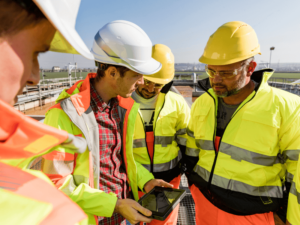In an era where urban landscapes continue to sprawl and the frequency of natural disasters seems to be on the rise, the importance of building resilient cities has never been more pronounced. Earthquakes, in particular, pose a significant risk to densely populated areas, with the power to cause extensive damage and incur millions in damage costs.
And to make matters worse, there is no way to know when the next big quake will shake up our cities or even prevent them from happening. This reality underscores the urgency to adopt a proactive approach to minimize their impact.
Let’s take a look at how strategic urban planning and the fostering of global partnerships can advance earthquake resilience, safeguarding the future of our cities and human continuity.
The Role of Strategic Urban Planning

Urban planning plays a pivotal role in enhancing earthquake resilience.
Predicting Vulnerability
The first step in building resilience against any natural disaster is having an accurate assessment of the threat. This is where performing a seismic hazards assessment becomes crucial. This process involves meticulously mapping out areas that are most vulnerable to seismic activities.
Questions, such as what areas of the city, in particular, are the most vulnerable? How many of the buildings in that area have been built to withstand an earthquake of a certain magnitude? What level of loss could be expected with that amount of ground shaking? How does the population density of the area factor into the potential impact of an earthquake?
By identifying these earthquake-prone zones, urban planners and authorities can impose stricter building codes tailored to mitigate the risks in these areas. Such regulations ensure that new constructions are not only structurally sound but also equipped with the necessary features to withstand the wrath of Mother Nature.
This proactive measure not only protects the structural integrity of buildings but also significantly enhances the safety of the residents within these zones. Implementing these strategies requires a deep understanding of local geology and the latest in earthquake engineering, ensuring that urban development proceeds in harmony with the natural seismic risks inherent to the area.
Retrofitting Existing Structures

The importance of retrofitting cannot be overstated when it comes to enhancing earthquake resilience. Many urban areas are dotted with older buildings that were constructed before the advent of modern earthquake-resistant standards. These structures pose a significant risk in the event of seismic activity, both in terms of potential casualties and property damage.
Retrofitting involves updating these existing buildings with new technologies and reinforcements that improve their ability to withstand the tremors of earthquakes. This may include the addition of steel braces, shock absorbers, and reinforced walls, among other modifications.
Retrofitting not only safeguards the buildings’ occupants but also preserves the cultural and historical value of older structures, ensuring they continue to be a part of the urban landscape in a safe and sustainable manner.
Reinforce Critical Infrastructure
In the wake of an earthquake, the immediate availability of critical infrastructure becomes paramount. Essential services such as fire departments, ambulances, 911 call centers, and healthcare facilities, from expansive hospitals to nimble urgent-care clinics, prove indispensable.
The fortification and preparedness of these vital infrastructures are non-negotiable for cities aiming to enhance their resilience against earthquakes. Proactive investment in these areas ensures that, in the face of seismic adversity, communities are equipped to respond swiftly and efficiently, significantly elevating their earthquake resilience.
Public Spaces and Emergency Routes
The design of public spaces and emergency routes is an essential element of urban planning for earthquake resilience. These areas must be thoughtfully planned to ensure they can accommodate and facilitate the rapid evacuation of people, as well as support efficient emergency response operations.
Public spaces, such as parks and squares, should be designed to serve as safe gathering points in the aftermath of an earthquake, where emergency services can provide aid and information.
Emergency routes, on the other hand, need to be clearly marked and kept free from obstructions, enabling both the evacuation of the public and the movement of emergency vehicles. Ensuring these pathways are wide, accessible, and well-maintained can significantly improve the overall effectiveness of the response efforts during and after an earthquake, ultimately saving lives and accelerating recovery.
Emergency Response Planning

For a city to effectively navigate the aftermath of an earthquake, a meticulously crafted emergency response plan is indispensable. This plan must address key questions: what needs to be done in the immediate aftermath of an earthquake? How will information be gathered? What are the priority actions, and who holds the authority to make crucial decisions?
Serving as an action blueprint, this plan is crucial for swift recovery and aid initiation. It must cover immediate post-earthquake actions such as damage assessment and shelter provision, alongside establishing robust information gathering and sharing systems. The plan should clearly define priorities, decision-making authorities, and outline coordination with higher authorities and broader networks, including state or national leadership and partnerships with the private sector, non-profits, and neighboring areas. This comprehensive approach ensures a city is well-prepared to address critical needs first, facilitating a smoother and more coordinated recovery process.
Fostering Global Partnerships for Disaster Response
 No city or country can stand alone in the face of natural disasters. Global collaboration is essential in sharing knowledge, resources, and technologies to enhance earthquake resilience. This process of knowledge sharing enables different stakeholders, including scientists, engineers, policymakers, and urban planners, to pool their expertise and insights. By doing so, they can develop a comprehensive understanding of earthquake dynamics, risk factors, and mitigation strategies. This collaborative approach not only accelerates the advancement of earthquake resilience methods but also can significantly enhance the capabilities of communities and nations to anticipate and react to seismic events.
No city or country can stand alone in the face of natural disasters. Global collaboration is essential in sharing knowledge, resources, and technologies to enhance earthquake resilience. This process of knowledge sharing enables different stakeholders, including scientists, engineers, policymakers, and urban planners, to pool their expertise and insights. By doing so, they can develop a comprehensive understanding of earthquake dynamics, risk factors, and mitigation strategies. This collaborative approach not only accelerates the advancement of earthquake resilience methods but also can significantly enhance the capabilities of communities and nations to anticipate and react to seismic events.
Through such exchanges, advancements like early warning systems and seismic retrofitting technologies can be more widely implemented, providing critical tools to mitigate the impact of earthquakes. This sharing of resources and technologies not only boosts the individual preparedness of entities involved but also strengthens the collective resilience of the global community against earthquakes.
Want to do your part in forging a world resilient against earthquakes? Join our mission. By aligning with us, you’ll amplify global efforts in earthquake preparedness, response, and recovery. Together, we can bolster community resilience worldwide, securing a safer tomorrow for everyone against seismic adversities.
Create Impact with us:
Join our membership and
contribution programs:
Participate in our
upcoming events:
Schedule a call with
our experts:
The Psychological Impact of Infrastructure Failures on Communities
Infrastructure is crucial for any community, serving as the backbone that supports our daily lives. It includes everything from the roads and bridges we travel on, to the water supply and electricity that power our homes. These systems are essential for society to function properly. But when infrastructure failures occur, the fallout can reach far […]
Cyber Resilience in the Energy Sector: Safeguarding the Grid from Digital Disruptions
In today’s interconnected world, the energy sector stands as a vital backbone of national and global infrastructures, facilitating everything from lighting our homes to powering industries. However, this sector is increasingly finding itself in the crosshairs of cybercriminals, making cyber resilience not just a matter of technological integrity but of national security. The concept of […]
The Role of Local Governments in Strengthening Infrastructure Resilience
The significance of local governments in strengthening infrastructure resilience cannot be understated. Often perceived as entities primarily focused on addressing routine community concerns and improvements, their responsibilities extend far beyond these day-to-day operations. In the realm of preparing for and mitigating the effects of large-scale, catastrophic events—referred to as “black sky” disasters—local governments emerge as […]

